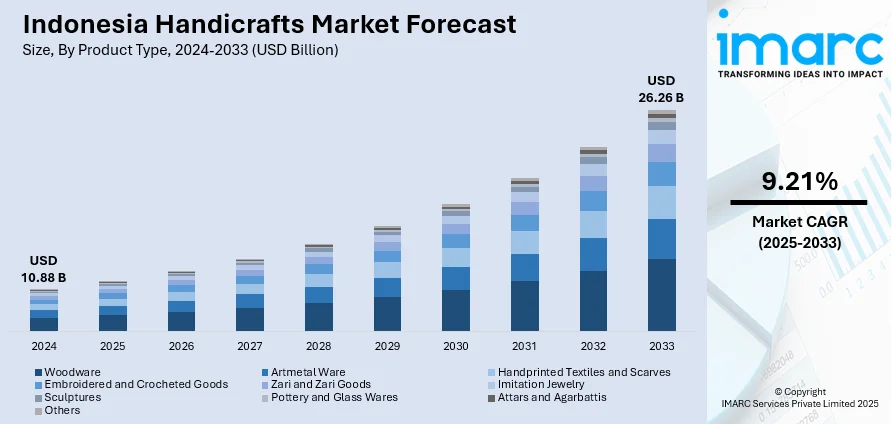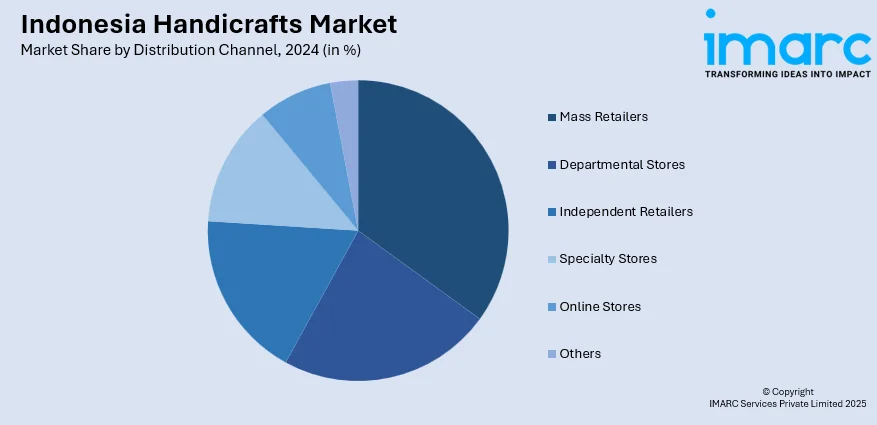
Indonesia Handicrafts Market Size, Share, Trends and Forecast by Product Type, Distribution Channel, End Use, and Region, 2025-2033
Indonesia Handicrafts Market Overview:
The Indonesia handicrafts market size reached USD 10.88 Billion in 2024. Looking forward, the market is projected to reach USD 26.26 Billion by 2033, exhibiting a growth rate (CAGR) of 9.21% during 2025-2033. The market is driven by a rich heritage of traditional craftsmanship, strong global export demand, and the rising preference for handmade, eco-friendly products. Government initiatives supporting artisans and international trade fairs have boosted visibility. Indonesia handicrafts market share is expanding due to its unique cultural and sustainable appeal.
|
Report Attribute
|
Key Statistics
|
|---|---|
|
Base Year
|
2024
|
|
Forecast Years
|
2025-2033
|
|
Historical Years
|
2019-2024
|
| Market Size in 2024 | USD 10.88 Billion |
| Market Forecast in 2033 | USD 26.26 Billion |
| Market Growth Rate 2025-2033 | 9.21% |
Indonesia Handicrafts Market Trends:
Expansion Through International Trade Platforms
Active involvement in international trade platforms is assisting the Indonesian handicrafts sector grow. These gatherings give craftspeople and producers a chance to present traditional crafts to consumers from around the world, including leather goods, bamboo, rattan, and batik. Local producers are increasing their market reach and bolstering their export potential by establishing connections with international distributors and retailers. Customers looking for distinctive, eco-friendly products from all over the world are drawn to the focus on handcrafted quality and cultural authenticity. Innovation, product variety, and improved quality standards are also being promoted by government programs and local industry associations. Indonesia's handicrafts market is expanding as a result of this worldwide exposure, establishing the industry as a competitive participant in the world's handcraft trade. For instance, the 25th Jakarta International Handicraft Trade Fair (INACRAFT 2025) opened on February 5, 2025 at the Jakarta International Convention Centre, where Indonesian handicrafts, including Batik, rattan, bamboo, and leather goods, were showcased. Held until February 9, the fair attracted 100,000 visitors, 1,000 international buyers, and achieved retail transactions worth 100 billion INR (USD 6.25 Million) along with commercial contracts of USD 1.5 Million, boosting Indonesia’s creative industry and global cultural presence.

To get more information on this market, Request Sample
Heritage-Inspired Contemporary Craftsmanship
Indonesia’s handicraft industry thrives on blending heritage techniques with modern design concepts. Traditional crafts such as batik, ikat weaving, and wood carving are being reinterpreted into contemporary home decor and lifestyle products. Designers collaborate with local artisans to create functional yet stylish items for modern homes while maintaining cultural authenticity. This fusion appeals to both domestic and global consumers who value unique, handcrafted pieces that tell a cultural story. Export demand for heritage-inspired crafts is rising, particularly in markets like Japan, Europe, and the U.S., where authentic handmade products are highly appreciated. For instance, as per industry reports, Indonesia’s furniture and handicraft exports reached USD 698.64 Million in Q1 2025, marking a 2.18% rise from last year. In 2024, total exports hit USD 2.598 Billion, with wooden furniture contributing 48.49%. This trend is significantly boosting Indonesia handicrafts market growth while preserving cultural identity.
Indonesia Handicrafts Market Segmentation:
IMARC Group provides an analysis of the key trends in each segment of the market, along with forecasts at the region/country level for 2025-2033. Our report has categorized the market based on product type, distribution channel, and end use.
Product Type Insights:
- Woodware
- Artmetal Ware
- Handprinted Textiles and Scarves
- Embroidered and Crocheted Goods
- Zari and Zari Goods
- Imitation Jewelry
- Sculptures
- Pottery and Glass Wares
- Attars and Agarbattis
- Others
The report has provided a detailed breakup and analysis of the market based on the product type. This includes woodware, artmetal ware, handprinted textiles and scarves, embroidered and crocheted goods, zari and zari goods, imitation jewelry, sculptures, pottery and glass wares, attars and agarbattis, and others.
Distribution Channel Insights:

- Mass Retailers
- Departmental Stores
- Independent Retailers
- Specialty Stores
- Online Stores
- Others
A detailed breakup and analysis of the market based on the distribution channel have also been provided in the report. This includes mass retailers, departmental stores, independent retailers, specialty stores, online stores, and others.
End Use Insights:
- Residential
- Commercial
The report has provided a detailed breakup and analysis of the market based on the end use. This includes residential and commercial.
Regional Insights:
- Java
- Sumatra
- Kalimantan
- Sulawesi
- Others
The report has also provided a comprehensive analysis of all the major regional markets, which include Java, Sumatra, Kalimantan, Sulawesi, and others.
Competitive Landscape:
The market research report has also provided a comprehensive analysis of the competitive landscape. Competitive analysis such as market structure, key player positioning, top winning strategies, competitive dashboard, and company evaluation quadrant has been covered in the report. Also, detailed profiles of all major companies have been provided.
Indonesia Handicrafts Market Report Coverage:
| Report Features | Details |
|---|---|
| Base Year of the Analysis | 2024 |
| Historical Period | 2019-2024 |
| Forecast Period | 2025-2033 |
| Units | Billion USD |
| Scope of the Report |
Exploration of Historical Trends and Market Outlook, Industry Catalysts and Challenges, Segment-Wise Historical and Future Market Assessment:
|
| Product Types Covered | Woodware, Artmetal Ware, Handprinted Textiles and Scarves, Embroidered and Crocheted Goods, Zari and Zari Goods, Imitation Jewelry, Sculptures, Pottery and Glass Wares, Attars and Agarbattis, Others |
| Distribution Channels Covered | Mass Retailers, Departmental Stores, Independent Retailers, Specialty Stores, Online Stores, Others |
| End Uses Covered | Residential, Commercial |
| Regions Covered | Java, Sumatra, Kalimantan, Sulawesi, Others |
| Customization Scope | 10% Free Customization |
| Post-Sale Analyst Support | 10-12 Weeks |
| Delivery Format | PDF and Excel through Email (We can also provide the editable version of the report in PPT/Word format on special request) |
Key Questions Answered in This Report:
- How has the Indonesia handicrafts market performed so far and how will it perform in the coming years?
- What is the breakup of the Indonesia handicrafts market on the basis of product type?
- What is the breakup of the Indonesia handicrafts market on the basis of distribution channel?
- What is the breakup of the Indonesia handicrafts market on the basis of end use?
- What is the breakup of the Indonesia handicrafts market on the basis of region?
- What are the various stages in the value chain of the Indonesia handicrafts market?
- What are the key driving factors and challenges in the Indonesia handicrafts market?
- What is the structure of the Indonesia handicrafts market and who are the key players?
- What is the degree of competition in the Indonesia handicrafts market?
Key Benefits for Stakeholders:
- IMARC’s industry report offers a comprehensive quantitative analysis of various market segments, historical and current market trends, market forecasts, and dynamics of the Indonesia handicrafts market from 2019-2033.
- The research report provides the latest information on the market drivers, challenges, and opportunities in the Indonesia handicrafts market.
- Porter's five forces analysis assist stakeholders in assessing the impact of new entrants, competitive rivalry, supplier power, buyer power, and the threat of substitution. It helps stakeholders to analyze the level of competition within the Indonesia handicrafts industry and its attractiveness.
- Competitive landscape allows stakeholders to understand their competitive environment and provides an insight into the current positions of key players in the market.
Need more help?
- Speak to our experienced analysts for insights on the current market scenarios.
- Include additional segments and countries to customize the report as per your requirement.
- Gain an unparalleled competitive advantage in your domain by understanding how to utilize the report and positively impacting your operations and revenue.
- For further assistance, please connect with our analysts.
 Request Customization
Request Customization
 Speak to an Analyst
Speak to an Analyst
 Request Brochure
Request Brochure
 Inquire Before Buying
Inquire Before Buying




.webp)




.webp)












